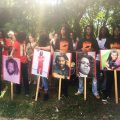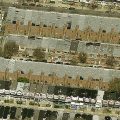By Wendell P. Simpson
ABOVE PHOTOS: Osage Ave. block captain Gerald Wayne Renfrow and protesters appear at a news conference at City Hall last week to protest that the city did not resolve the situation that resident be reimbursed.
Photos by William T. Wade Jr.
On the afternoon of May 13, 1985, the enmity between the radical MOVE organization and the City of Philadelphia devolved into slaughter when police dropped a bomb, from a helicopter onto a row home in the 6200 block of Osage Avenue in West Philadelphia, where the group was holed up.
The ensuing explosion rapidly evolved into a massive conflagration that trapped MOVE members in the house, killing 11, including children, and consumed two blocks of a working class neighborhood. People lost the precious memories and affectations of their lives, and any trust in a city with an horrific record of conflict resolution and racial insensitivity.
Philadelphia was a city already polarized along racial, ethnic, political and economic lines when, in 1972, a self-styled philosopher named John Africa founded MOVE. The group’s original premise was a rebellion against an overly technical society in which the people had forgotten their connection to the natural world. All members of the mostly Black group took on the surname ‘Africa’ as homage to the motherland.
The group’s antagonistic relationship with the city began when it bivouacked in the middle-class enclave of Powelton Village. In addition to allowing the property to become a virtual wild-life preserve—animals were allowed to run free; house residents began feeding the growing herd of rats; and garbage was ‘recycled’ by being heaved into the yard—MOVE members began proselytizing their philosophy with a nightly verbal barrage over amped-up loud speakers.
Neighbors’ complaints drew the Philadelphia Police Department into direct confrontation with the group, who saw police as an instrument of institutional oppression. Verbal assaults on behalf of both parties escalated until a 1978 confrontation turned bloody when gunshots were exchanged. When the smoke cleared, one police officer was dead, several combatants on both sides were injured, remaining MOVE members were arrested, and the group’s headquarters was bulldozed to the ground. MOVE was dead—or so every one thought.
Periodic eruptions between MOVE associates and Philly police continued to occur—the most notable being the alleged murder of another Philadelphia police officer by journalist and MOVE associate Mumia Abu Jamal, a case that has become a cause celebre among amnesty groups around the world..
By 1985, the group had re-established itself on Osage Avenue where MOVE’s belligerence once again brought it into conflict with it’s neighbors, and, once again, after months of complaints, the police finally responded.
This time, however, MOVE was going to be harder to dislodge as group members had turned the row home into a fortified bunker. According to residents of the beleaguered neighborhood, the police department had ample opportunity to apprehend individual members of the group who took periodic forays out into the neighborhood.
The city, anxious to finally rid itself of the troublesome entanglement and frustrated by years of failed efforts to curtail the group, evacuated the Osage Avenue neighborhood, and in the pre-damn hours of May 13, 1985, Mayor Wilson Goode approved the attack that led to the bombing.
Eleven people in the MOVE house, including six children, were incinerated.
To this day, the legacy of that unfortunate day continues to impact Philadelphia and it’s people. In many parts of the world, Philly is known for three things: cheesesteaks, the Liberty Bell and the MOVE bombing. The incident has become so renowned it has been immortalized in song by bands as disparate as Rage Against the Machine, Ice Cube, Kanye West, the Last Poets and the Fifth Column.
The people whose homes and memories and histories burned up in that horrific inferno are still wrestling with the terrible trauma. Lawsuits continue to swirl, housing issues continue to be bandied about. Unresolved issues keep the horror fresh in the minds of Philadelphians who have never reconciled that dreadful day.
The MOVE bombing is the ghost that cannot rest.
Gerard Wayne Renfrow still lives in the same Osage Avenue house—or rather, at the same address—in which he resided when the bomb upended everything. To this day, Renfrow still struggles with the legacy of that day.
“MOVE disrupted our community,” said Renfrow. “We asked the city to address it. They addressed it with the bomb. We didn’t expect the city to kill anyone.”
Renfrow believes the city could have resolved the MOVE issue through negotiations, but he harbors suspicions that the fire was purposely allowed to burn.
“We believe the entire incident was about gentrification,” said Renfrow “This neighborhood is located in a prime area, close to transportation and access to the city. The fire department knew they couldn’t fight the fire when the bomb was dropped.
Dave Levinson grew up near the original Powelton Village MOVE house. He remembers having a passing acquaintance with Delbert Africa. “I would walk pass the house on my way to the laundromat,” said Levinson. “Delbert would talk to me about the MOVE philosophy. It was a little more than I wanted to handle, they were saying some crazy sh*t, but they weren’t attacking anybody. They were more talk than anything else.
“After the incident when the cop got shot, and everyone was arrested, and the house was torn down and I think everybody thought that was the end of it.
“They weren’t the best neighbors in the world,” Levinson said. “They were feeding rats and the compound smelled, but they didn’t deserve to die because of it. The bottom line is, the cops could’ve handled the whole thing differently.”
Dr. Valda Dawson remembers the concussion of the blast that rocked her home and changed her perspective on humanity. “I lived about three blocks away and felt the explosion,” said Dawson, who was working for a state legislator at the time of the bombing. “My boss and I toured the area the next day. I felt like I was in a war zone. As I looked around at the damage, it really impacted me to know that people had perished in such an horrific manner.”
Amy Simmons is has been able to put the trauma into philosophical perspective. “It was a time of contradiction and tension on both sides,” said Simmons. “There was ever going to be a peaceable solution. What it ultimately led to was a full blown Willie Lynch effect that was enforced by the majority in charge of the media, and the polarizing political machinery in this city. Don’t forget, the first action was a (former Mayor and Police Commissioner) Frank Rizzo solution.”
DeeMaria Moreno believes the City of Philadelphia engaged in a selective persecutorial campaign against a radical organization with which it disagreed. ‘I had one question,” said Moreno. “Why? Because the family Africa did not conform or assimilate? Everything was wrong, really. The bomb on the roof was the most asinine thing to do! And the family Africa, with all that they knew and understood, should have used the education to create a brilliant future for their young. Instead, they used their un-education and misplaced the truth and murdered the future. So, I remember nothing of any value. It was all a waste.”
















Leave a Comment